A positive brand image can undoubtedly influence a consumer's decision to buy a product — and, for virtually every business, building a positive brand image starts online.
Nowadays, your reputation is largely dependent on social media and online review sites. For instance, consumers need to read an average of 10 online reviews before they feel they can trust a local business.
Since brand image makes such an impression on someone's decision to purchase, you must regularly monitor your reputation online. Still, it can feel like a daunting task, particularly when so much of it is out of your control.
Fortunately, there are plenty of tools and strategies you can implement to ensure you're protecting your brand in 2021. In this post, we’ll give a clear overview of brand reputation management, how to create a plan to manage your business reputation, and high-quality tools to supplement your process.
Reputation management is a continuous process, as it allows you to stay on top of your brand’s public perception and address possible damaging situations as soon as they occur.
When your reputation is positive, you inspire customer loyalty, a significant driver of revenue and growth. A negative reputation can be damaging to sales and customer retention, but it also helps you learn about what customers like, which can be helpful for updating business processes to better meet consumer needs.
Brand safety has recently become discussed in conversation with reputation management, and we’ll explain what it is below.
Brand Reputation Management vs. Brand Safety
According to the Internet Advertising Bureau, brand safety ensures that advertisements, their content, and any content shared by brands are appropriate and not associated with topics of consumer opinions that may be negative. Although somewhat similar concepts, brand safety falls into brand reputation management.
Some examples of scenarios that risk brand safety are correct ad placement. The IAB recommends purchasing ad space from trusted publishers so your ads aren’t next to content that consumers may find offensive or cause them to distrust your brand.
In another scenario, you want your advertisements to be related to what you're advertising. If customers click on an ad for a new blanket and are led to unrelated content, you’re practicing malicious advertising, which risks the safety of your consumers.
Brand safety goes both ways; your business is protected from outside sources that aim to harm, and your customers are protected from malicious business practices that may cause them to lose money or be exposed to offensive things.
So, as a whole, brand safety is a process within brand reputation management. You’re ensuring that your advertising practices are legitimate, so consumers don’t feel deceived by your brand and don’t need to second-guess your business and distrust what you have to offer.
Reputation Management Plan
Let’s go over a sample reputation management plan that you can adapt to fit your business needs. It’s essential to keep in mind that reputation management is a continuous process, so neither step is one-and-done; they should be consistent as long as your business is up and running.
1. Research and audit.
The first step to reputation management is research. During this phase, you’ll use the internet to discover conversations about your business and what people are saying about you. Aim to seek out all different types of conversations, as all feedback is helpful for understanding perceptions and improving your reputation.
You can conduct this audit from your customer reviews, on review sites, on social media, and by simply searching for your business’s name on Google and various search engines. You can also search for business-relevant keywords or even the feeds of your competitors. Consumers are talking; you just have to meet them where they already are.
As there are many different platforms and websites you’ll use to conduct your research, using a high-quality reputation management tool will make the process easier, and we’ll recommend some below.
2. Establish a management strategy.
Once you know what overall perception is of your brand, you’ll know where you’ll need to focus to improve it. For example, suppose your audit shows that the conversation around your brand is unfavorable. In that case, you will want to employ practices that will help you improve the experiences that people have with your business.
As such, the next step is to create a consistent management strategy. Regardless of what your current standing is, your plans should address the following:
- Who will consistently monitor online conversations?
Designate specific people at your business to be in charge of conducting continuous research and monitoring conversations about your business online. Those already on customer-facing teams are likely the most equipped to deal with customers, like those on marketing or customer service teams.
Either way, those who monitor online conversation and respond to comments should have experience doing so, and understand how to speak with customers.
- How do you decide which comments, reviews, or mentions need responses?
Some people’s only intent is to troll rather than speak about legitimate experiences. These comments and conversations are fake, created on purpose to diminish your reputation. Most comments, however, are based on real interactions, experiences, and thoughts about your brand, both positive and negative.
You should never respond to reviews that seem fake (here’s a guide on spotting and removing them from Google). However, you should respond to comments from real consumers, which is why it’s essential to understand which warrant a response.
It’s not possible to respond to all of them, so maybe you prioritize responding to customer questions or create specific requirements that dictate when a response is necessary, both for positive and negative comments.
- A tone guide for responding to comments.
Responding to comments and conversations about your brand is not worth it if you don’t have a consistent tone of voice that you follow. For example, if you respond to criticism harshly but positive comments with returned positivity, it will do more harm than good.
Develop a standard tone guide that you will use when responding, and aim to stick to it. It can also be helpful to have a crisis management plan in place within your reputation plan to take action during situations that escalate quickly, are difficult to control, and may leave responsible parties frantic and not adhering to standard guidelines.
3. Take action based on comments, feedback, and reviews.
Understanding how consumers view your brand is the most valuable tool for improvement and innovation. Their criticisms and pain points will direct you to areas of your business that need increased attention, and their positive comments let you know what you’re doing right and what you should continue doing.
As you’re hoping to manage your reputation, taking action based on comments, feedback, and reviews helps you manage your reputation as you’re making changes that customers want to see.
4. Continuously practice steps one, two, and three.
As mentioned above, managing your online reputation is a continuous effort. Although it may be nice, rectifying one situation doesn’t mean that everything is smooth sailing from now until forever.
Always research and monitor conversations about your business to get a sense of where your reputation stands, follow the steps of your plan, and act on the feedback you receive.
Let’s go over some high-quality tools you can use to supplement your reputation management process.
Reputation Management Software
It can be helpful to use reputation management software, particularly if you work for a small-to-medium-sized business with limited PR resources. Below we’ll review some options.
1. Yext Reviews
Since inconsistent information can negatively affect your local SEO, it's critical you ensure your business's data is listed consistently across each site. Fortunately, Yext lets you fix any inconsistent business information all in one place.
Additionally, the software enables you to manage your social media accounts and respond to authentic customer reviews, ensuring you have a good grasp on your brand's true online reputation. Yext is ideal for small-to-medium-sized businesses as well as major enterprise companies — some of its impressive customers include Marriott Hotels and T-Mobile.
Price: Starts at $199/year
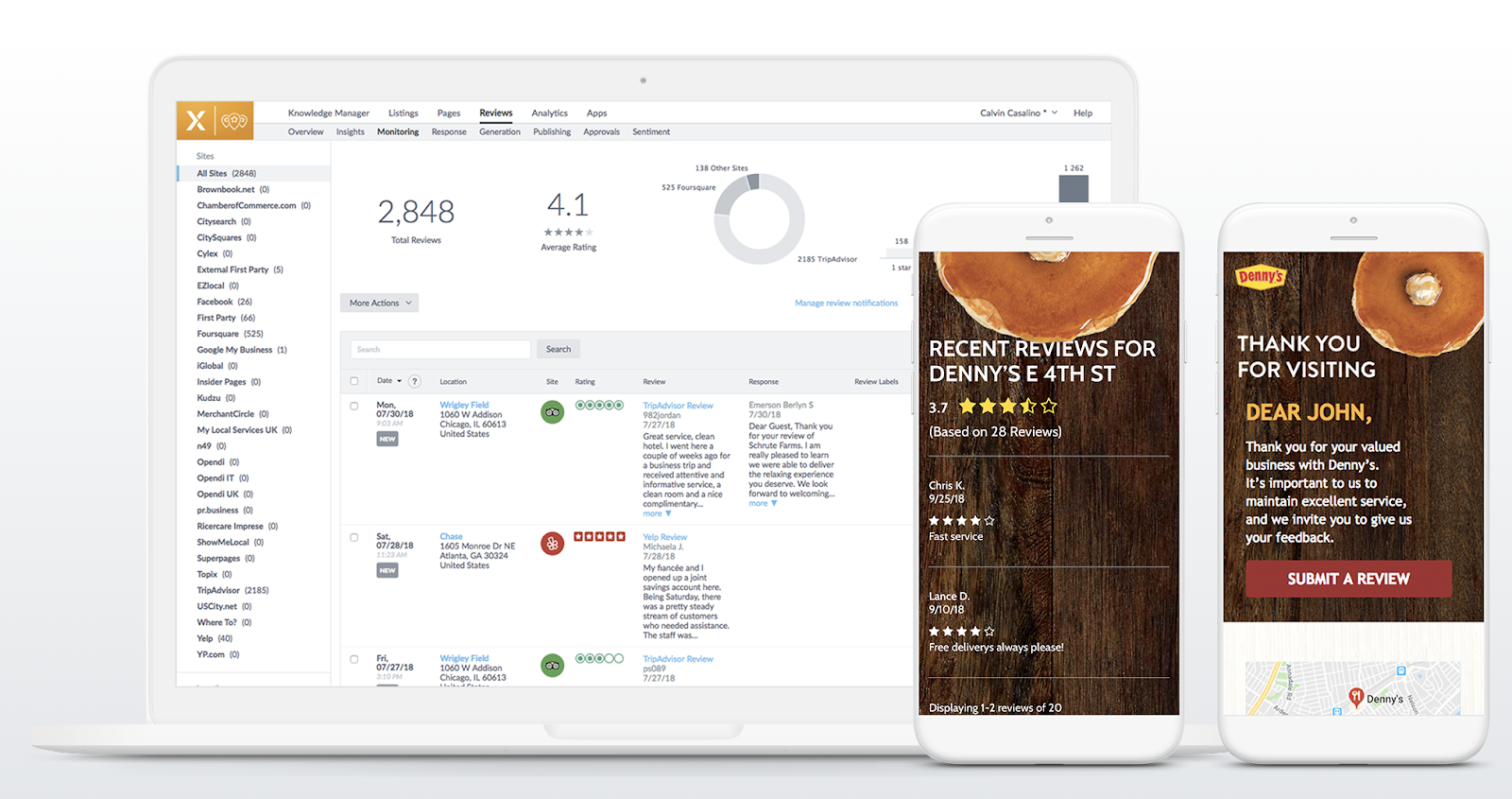
2. ReviewTrackers
ReviewTrackers collects online reviews from over 100 third-party review sites, including Google, TripAdvisor, and Facebook. A critical feature to call out is that you can receive notifications whenever a customer leaves a review, ensuring you're up-to-speed on feedback.
The cloud-based reputation and review management software also allows you to track trending issues and topics to show you the bigger picture around customer issues and provides competitor tracking and performance analytics.
The tool, used by customers such as Sears and Triple A, is available for enterprise companies and small-to-medium sized businesses.
Price: Custom depending on your size and business needs (request a demo here).
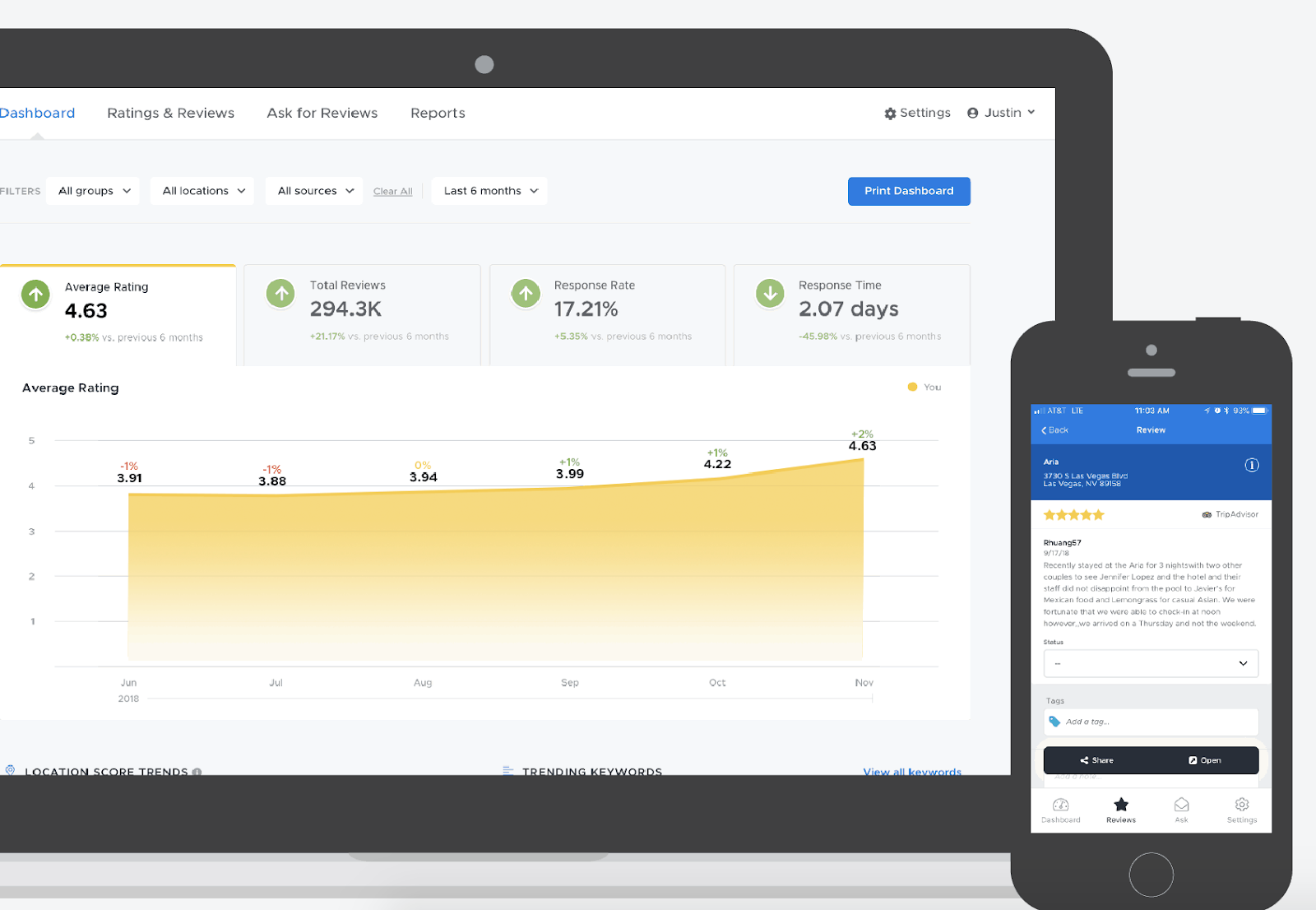
3. Podium
More than likely, the idea of managing your reputation on different sites ranging from Facebook to Google to Yelp is a stressful and overwhelming one — fortunately, software like Podium allows you to see all customer interactions and online reviews in a single dashboard. Your employees can use Podium to request reviews, respond to reviews in real-time, and even exchange text messages with potential customers.
Podium's support team is available via phone, online chat, or email, ensuring you have the help you need to properly implement their tool. The software works best for small-to-medium local businesses with the time and resources to manually send texts to customers or leads.
Price: Custom depending on your size and business needs. (Ask for a quote here).
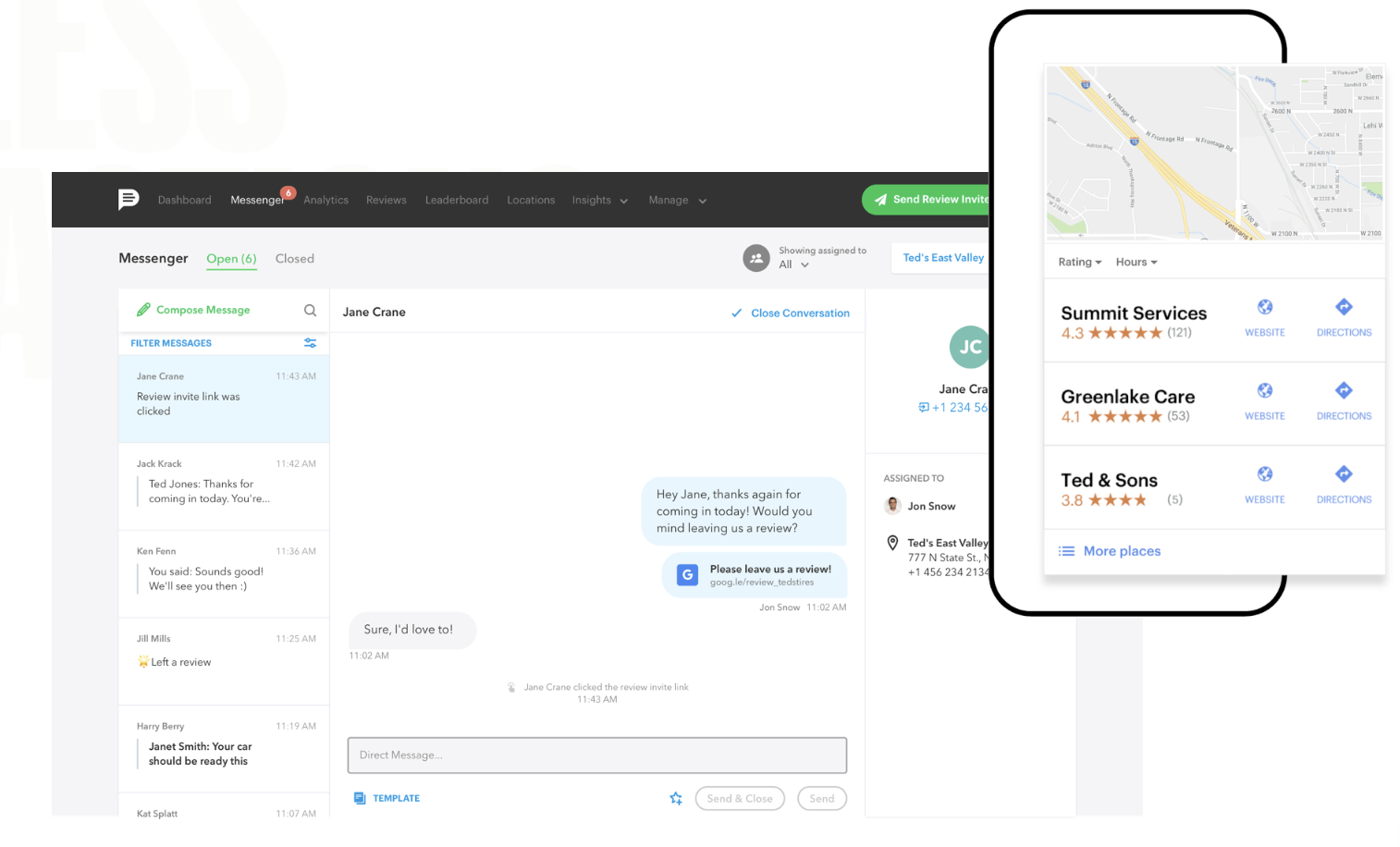
4. BirdEye
BirdEye, a SaaS tool used by more than 50,000 businesses, collects feedback from over 150 online review sources to ensure you have the complete picture regarding your brand's online reputation.
You can monitor, promote, and respond to reviews within one dashboard. Additionally, you can use BirdEye to request reviews from customers on both desktop and mobile devices or within BirdEye's messenger tool.
Along with review monitoring, BirdEye provides features to manage your social accounts, gain insight into your competitors' customers, and create surveys and tickets to further improve your customer's overall experience with your brand.
Price: Custom depending on your size and business needs. (Ask for a quote here).
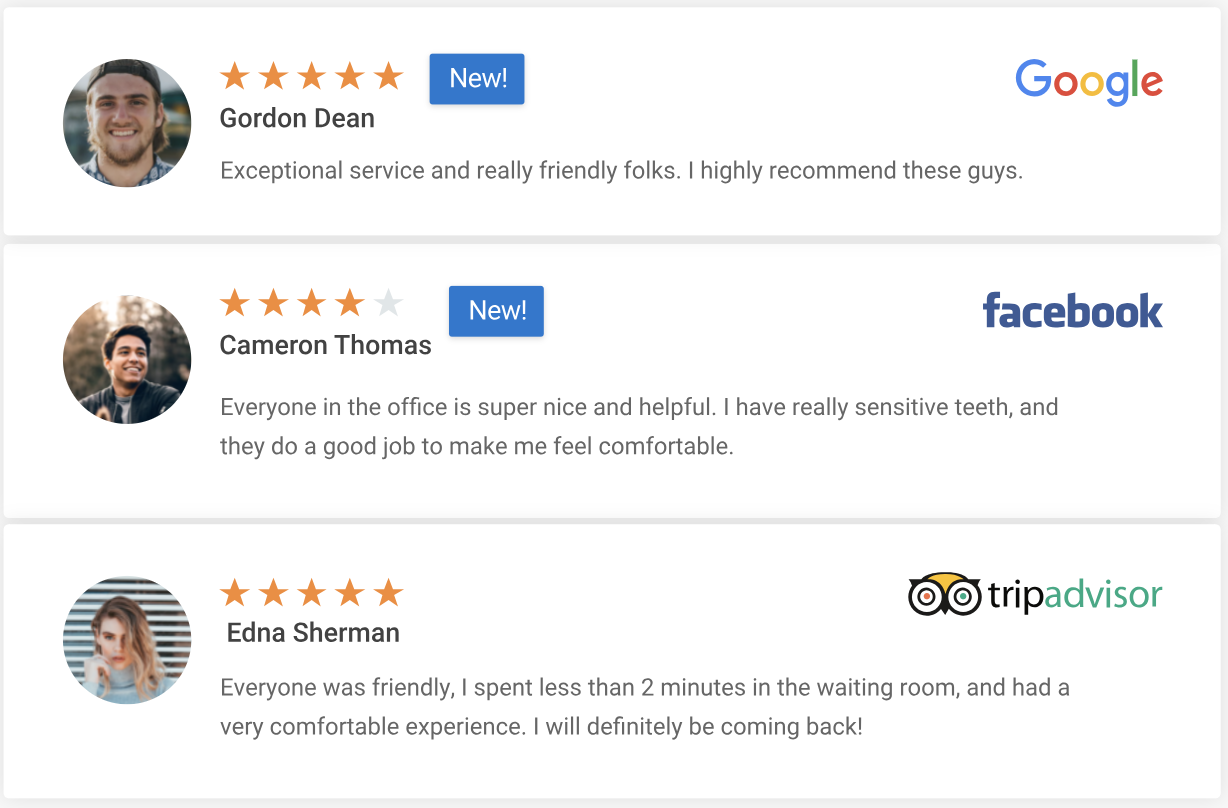
5. Cision
Cision Communications Cloud lets you track your brand mentions across millions of online stores, as well as any social media mentions. Best of all, Cision helps you reach audiences across traditional, digital, and social platforms, ensuring your brand is thriving across all marketing channels.
While Cision provides tools to ensure you're able to monitor and protect your online brand, its features are particularly impressive for strategic, proactive PR outreach. For instance, Cision helps you find media outlets and specific contacts within the industry to reach out with pitches, or figure out which industry influencers can best help spread your message and positively impact your brand's image.
Cision also provides automated analysis to help you translate your campaigns into valuable global insights. The tool is used by companies such as Comcast and Bayer.
Price: Custom depending on your size and business needs. (Ask for a quote here).
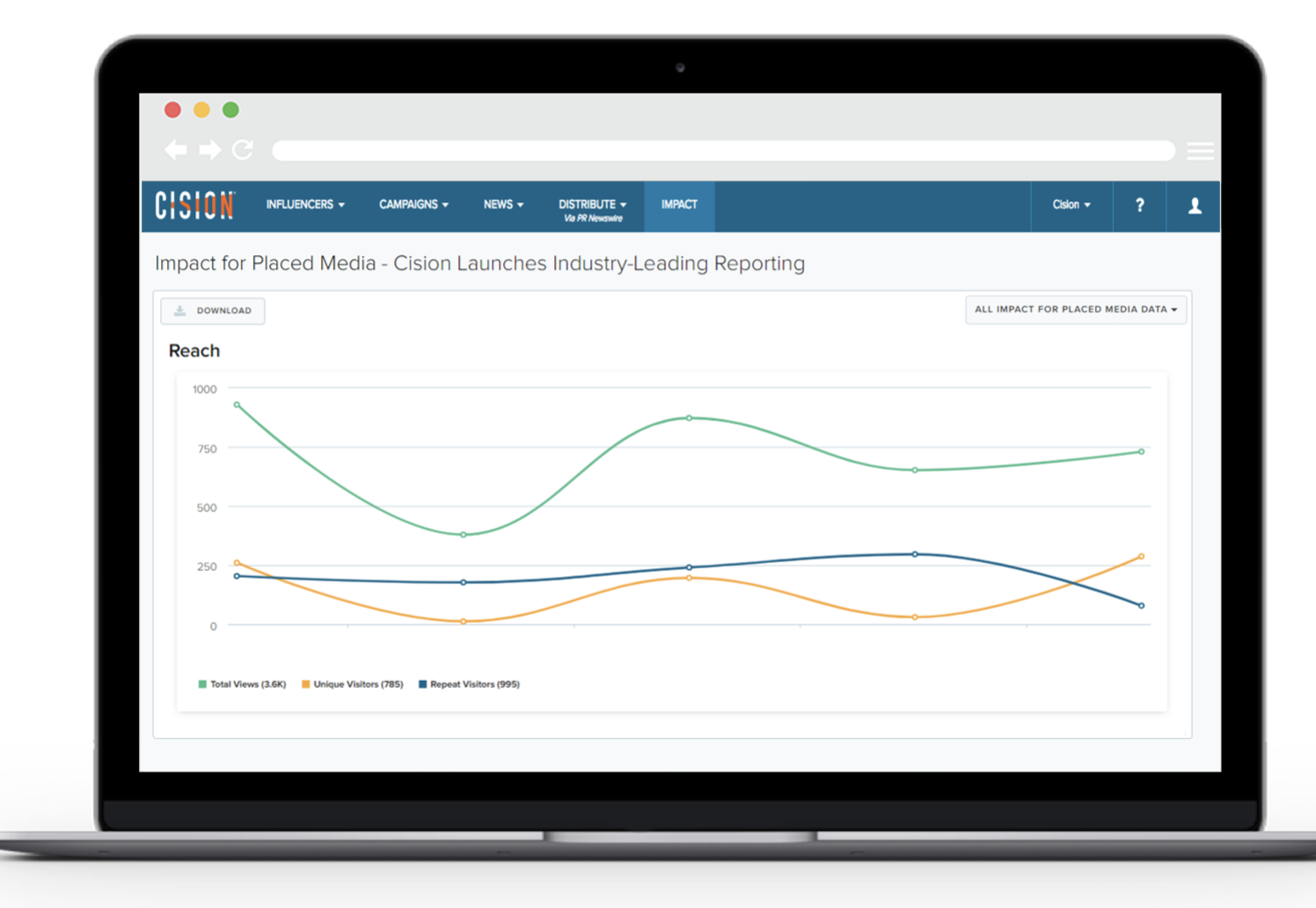
Reputation Management for Businesses
To understand how a business might implement a reputation management strategy, I spoke with Ellie Flanagan, Senior Corporate Communications Manager at HubSpot.
She told me — "The first step in shoring up your brand's presence online is making sure that all of your owned channels reflect your current imagery, messaging, and values. Check for outdated logos, company descriptions, or mission statements. It's also helpful to do regular audits of other places where your logo or brand might be in use — such as on partner or customer websites."
To conduct regular audits, you might use one of the software tools listed above. Additionally, you can use reputation management software to check for inconsistencies, such as Yext. Alternatively, there are tools such as Express Update or My Business Listing Manager that help you monitor for outdated information (check out A Comprehensive Guide to Local SEO in 2021 to learn more).
Flanagan also says, "Make sure you have clear language on your website that outlines your company's trademarks and sets guidelines for how others can use your brand assets. That will be a helpful reference if you need to reach out to someone who's using your brand incorrectly or without permission."
I also spoke with Alice Sol, a Public Relations Specialist at HubSpot. She told me — "Protecting your brand has never been more important, and that goes hand-in-hand with customer trust. We live in a world where information travels rapidly, and we can get a response in seconds at the touch of a button. Technology has enabled us, as consumers, to get in touch with brands quickly — at the same time, it's given brands the ability to form deeper connections and resolve issues faster."
Sol also advises businesses to do their best to meet customer needs and ensure a seamless experience, start-to-finish. She says, "The stakes [on delivering a good experience] are getting higher. 80% of consumers say they have stopped doing business with a company because of a poor experience. If a customer has a bad experience, technology allows information about that experience to travel quickly. At the same time, if a customer has a very positive experience, that creates a strong brand reputation and forms trust."
"Your customers are your biggest asset and it's critical to take those needs very seriously by responding in a timely manner and communicating effectively."
To sum it up, when protecting your online reputation, you'll want to focus on the following tactics:
- Make sure all your owned channels reflect your current imagery, messaging, and values,
- Ensure all online information regarding your business is up-to-date and consistent,
- Use precise language on your website to outline your company's trademarks and set guidelines,
- Cultivate a positive user experience, start-to-finish,
- Listen to customer feedback and respond to negative feedback with helpful, actionable solutions when possible.
If you want further information regarding how to cultivate a comprehensive, cohesive customer experience, take a look at How to Define a Customer Experience (CX) Strategy, which provides you with the six areas of a successful digital customer strategy.
Reputation Management: How to Protect Your Brand Online in 2021 was originally posted by Local Sign Company Irvine, Ca. https://goo.gl/4NmUQV https://goo.gl/bQ1zHR http://www.pearltrees.com/anaheimsigns


No comments:
Post a Comment